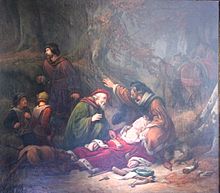Waldemar (Schleswig)
Waldemar von Schleswig (* 1209 ; † November 28, 1231 on Refsnæs), also "Waldemar the boy" ( Danish : "Valdemar den Unge") or Valdemar III. called, was Duke of Schleswig from 1209 to 1215 and as co-regent of his father Waldemar II. King of Denmark from 1215 until his death.
Life
Waldemar was the eldest son of Waldemar II and his first wife Dagmar of Bohemia . At the age of six he became co-regent, but did not survive his father and was therefore neither his successor nor sole ruling monarch. Sometimes he is also Waldemar III. called, for example, the Latin inscription on his tombstone reads:
Nevertheless, the term "Waldemar III." Is mostly used to either denote his nephew as Duke Waldemar III. of Schleswig or his great-great-nephew as later King Waldemar III. of Denmark to designate. The young king should not be confused with the ambitious bishop Waldemar von Schleswig (* 1157/58; † 1235/1236) who was half a century older, but also active .
childhood
Waldemar was born in 1209. He was the eldest son from the father's first marriage. His mother, Queen Dagmar, died in childbed in 1212, leaving her husband a widower with a young son. She had been very popular among the Danish people for her piety and kindness. King Waldemar married Berengaria of Portugal two years later . From this marriage Waldemar von Schleswig had four half-siblings: Erik , Sofie, Abel and Christoffer . His new stepmother, a beautiful and proud woman, unpopular and little respected among the Danish people, was a great contrast to Waldemar's mother Dagmar. Berengaria died in childbed in 1221, King Waldemar did not remarry.
Junior king
At a meeting of the Danish magnates, which King Waldemar had convened on Samsø in 1215, everyone agreed to take an oath on the young Waldemar. Shortly afterwards he was elected co-king of Denmark with the Viborg Landsthing, a procedure originally practiced in France by the Capetians and later in many European monarchies. At the same time, Waldemar handed over the Duchy of Schleswig to his younger brother Erik. During a big festival in Schleswig in the summer of 1218, at which 15 bishops and 3 dukes were present, Waldemar was anointed and crowned junior king of Denmark in Schleswig Cathedral .
Hostage
Together with his father, the young Waldemar took part in the unfortunate hunt on the island of Lyø in 1223, during which both kings were captured by Henry I of Schwerin . Both were imprisoned in the Waldemarturm of Dannenberg Castle in 1224 and 1225 . After imprisonment in Schwerin, the young Waldemar was imprisoned until Easter 1226. For the release of father and son, Count Heinrich demanded that Denmark hand over the lands conquered in Holstein 20 years ago and become a vassal of the Holy Roman Empire . Danish ambassadors refused these conditions and Denmark declared war. While the kings were in prison, most of the German territories broke away from Denmark. Danish troops were sent to keep them “busy” ( flag ). The war ended with the defeat of the Danish troops under the command of Albrecht von Orlamünde in Mölln in 1225. In order to obtain their clearance, Waldemar II had to acknowledge the assignment of territory to Germany, pay 40,000 pounds of silver and sign a promise not to revenge on Count Heinrich and send his son Erik to jail instead.
marriage
The young King Waldemar married on June 24, 1229 in Ribe Eleanor of Portugal , daughter of Alfonso II of Portugal and niece of Waldemar's stepmother. The meeting of the two had been arranged by Bishop Gunner of Viborg , who loved the couple like a father. They had only been married for two years when Queen Eleanor died in childbirth on August 28, 1231. The child lived only a short time.
death
On November 28, 1231, young Waldemar was accidentally shot while hunting Refsnæs near Kalundborg . He died the same day. Waldemar was praised for his gentleness and kindness in every direction and was very popular. A spiritual writer's Latin elegy, which he wrote when the kings were captured, mentions him with the best words of praise. There was great sorrow in the country when he was killed. He was buried in St. Bendts Church in Ringsted next to his wife, Queen Eleonore. His father then made his younger half-brother Erik co-king. King Waldemar II died ten years later and Erik succeeded him.
See also
Individual evidence
- ↑ Valdemar the Unge . In: The Danske store. Gyldendals åbne encyclopædi .
- ^ Valdemar (III) . In: Carl Frederik Bricka (Ed.): Dansk biografisk Lexikon. Tillige omfattende Norge for Tidsrummet 1537-1814. 1st edition. tape 18 : Ubbe – Wimpffen . Gyldendalske Boghandels Forlag, Copenhagen 1904, p. 183 (Danish, runeberg.org ).
- ↑ Ellen Jørgensen (ed.): Annales Danici medii aevii , Copenhagen 1920, p. 151. Dietrich Ellger: Die Kunstdenkmäler der Stadt Schleswig. Second volume: The cathedral and the former cathedral district . Deutscher Kunstverlag, Berlin 1966, p. 4.
| predecessor | Office | successor |
|---|---|---|
| Waldemar II. |
 Duke of Schleswig 1209–1215 |
Eric |
| personal data | |
|---|---|
| SURNAME | Waldemar |
| ALTERNATIVE NAMES | Waldemar of Schleswig; the young Waldemar; Valdemar den Unge (Danish) |
| BRIEF DESCRIPTION | Danish co-regent and King of Denmark |
| DATE OF BIRTH | 1209 |
| DATE OF DEATH | November 28, 1231 |
| Place of death | on Refsnæs |

